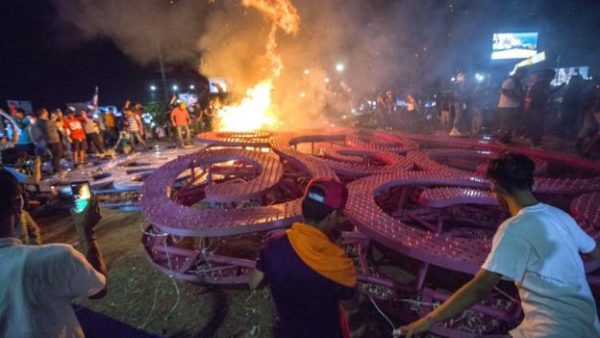VP Murillo to Reinstall Metal “Trees of Life” in Managua

Each “tree of life”, a whim of VP Rosario Murillo, had a price tag of $20,000 in 2017, not including electricity and maintenance costs.
HAVANA TIMES – Sixteen “trees of life,” better known as “chayopalos” (named for Rosario Murillo’s nickname, Chayo, and “palo” to mean “tree”) or “tin trees,” were reinstalled in Managua on Sunday, June 23, according to Rosario Murillo, spokeswoman and vice president of the Ortega regime, through pro-government media. The reinstallation is being carried out six years after dozens of these metal structures were demolished during the citizen protests of the April Rebellion of 2018.
Murillo did not specify the cost of the “trees of life,” as she calls them, or of their installation. However, each “chayopalo” or “metal tree,” as citizen protesters renamed them, had a price tag of some $20,000 in 2017, not including electricity or maintenance costs. In addition there were security costs, because each group of metal structures was “looked after” by a security guard.
According to Murillo, the reinstallation is “in recognition of the heroic deeds of so many Heroes and Martyrs who gave their lives so that now we can live with dignity and sovereignty.” She did not specify which heroes and martyrs she was referring to, but the dictatorship omits the more than 300 people assassinated during the brutal repression and massacres ordered against the protests; she only mentions police and Sandinista militants in the list of dead.

“Chayopalos” for Carlos Fonseca… and maybe for Chayo’s birthday, too?
The regime’s only spokesperson and vice-president added that the reinstallation of the “trees of life” is also a salute to the founder of the Sandinista Front, Carlos Fonseca, born on June 23, 1936 and assassinated on November 8, 1976, in Zinica, Waslala, during the guerrilla struggle against the Somoza dictatorship. June 23 is also Nicaragua’s Father’s Day celebration. Murillo said the trees are for Nicaraguan fathers, too. She did not mention that the return of her “chayopalos,” or “tin trees,” is also being done around her birthday: She turned 73 on June 22.
“Saluting our Comandante Carlos, saluting all Nicaraguan fathers, installing these symbols, these hallmarks of life and hope, as Rubén [Darío] used to say, and how much life, how much hope, how much triumph we have in this Nicaragua of ours, where we are together building the future we want, that we deserve and that we’re building in peace,” Murillo said, according to a review of her speech published in El 19 Digital.
Cost of 16 metal trees would exceed US $320,000
If the cost of the “chayopalos” or “tin trees” is the same as estimated in 2017, the reinstallation of these 16 would cost $320,000. Murillo did not say where the resources to pay for her “trees of life” came from, nor how they are being paid for.
In previous years, some versions of these structures were installed in other provinces of Nicaragua. For now, according to official information, these “trees of life” would only be reinstalled in Managua, the Nicaraguan capital city hit in recent weeks by floods caused by several tropical storms that are affecting the country.
The cost of each reinstalled “chayopalo” or “tin tree” could be higher this time because Murillo also said that there would be “inauguration ceremonies in the different locations where,” according to her, “life is being illuminated” with her structures.





